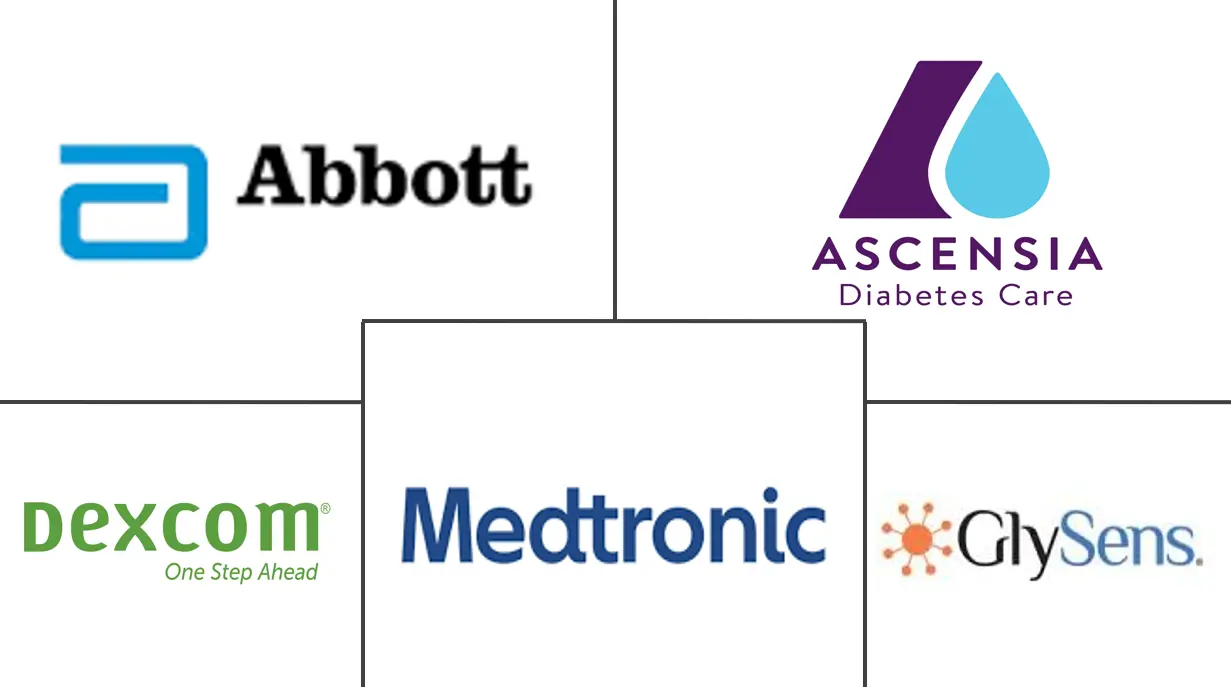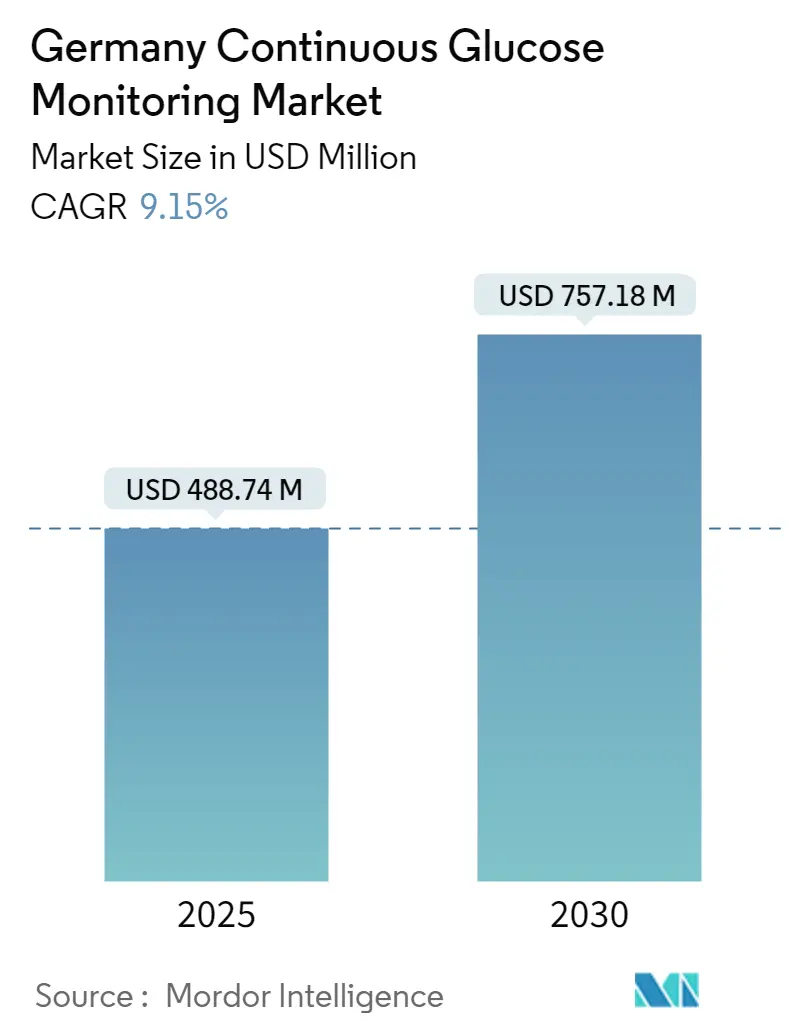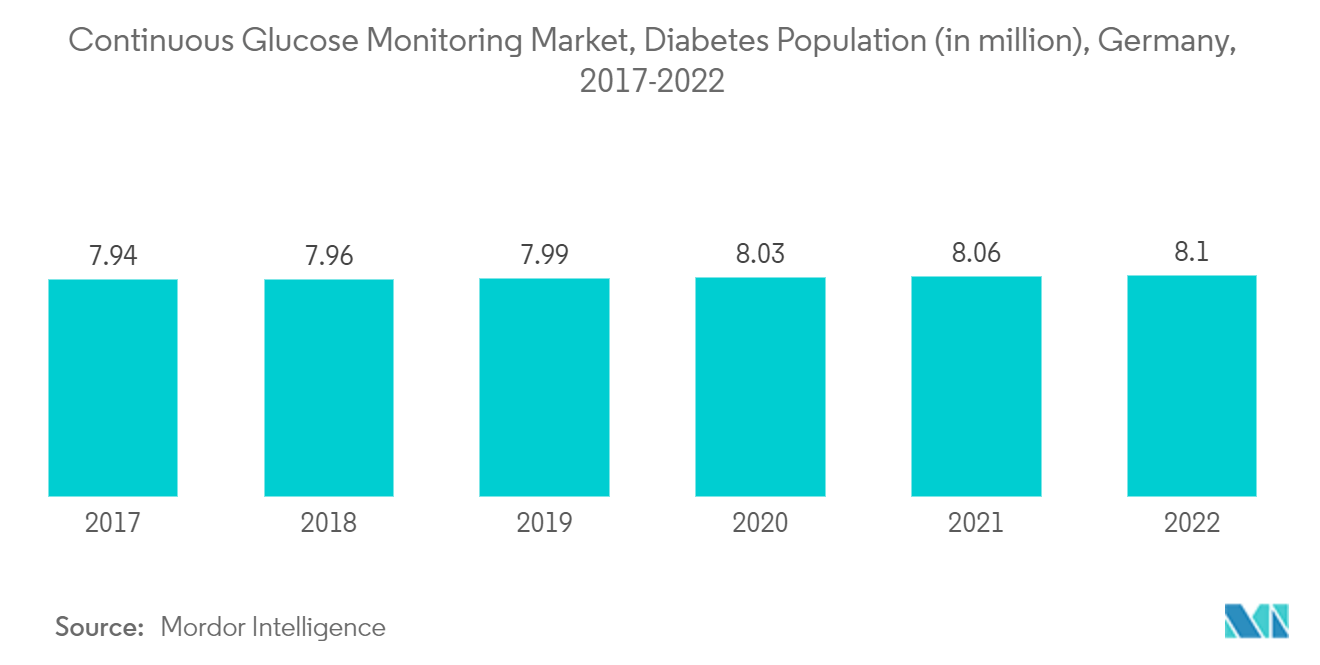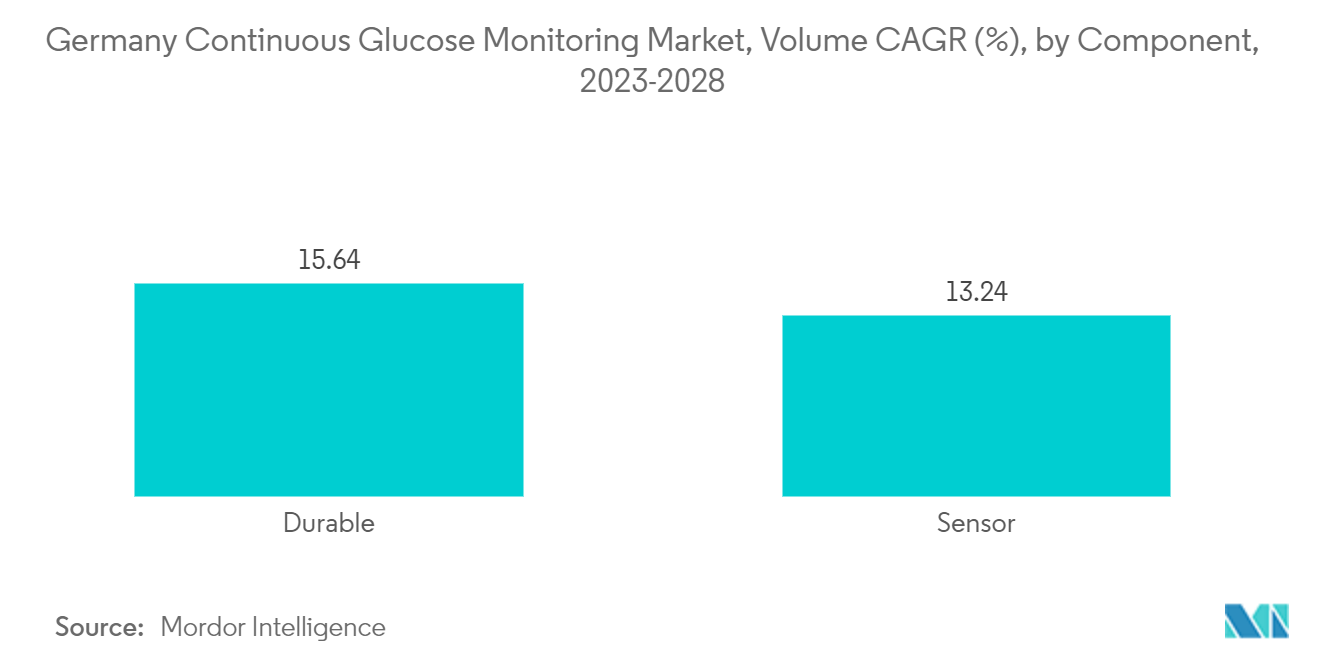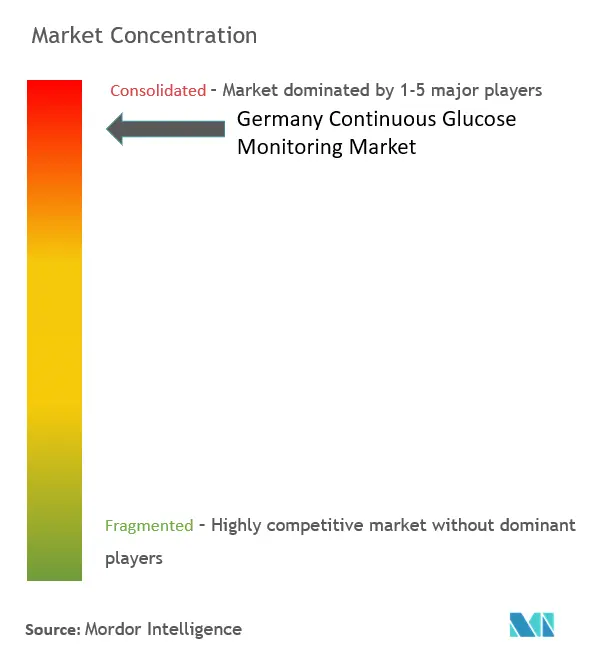Germany Continuous Glucose Monitoring Market Analysis
The Germany Continuous Glucose Monitoring Market size is estimated at USD 488.74 million in 2025, and is expected to reach USD 757.18 million by 2030, at a CAGR of 9.15% during the forecast period (2025-2030).
One of the most significant risk factors for a severe course of COVID-19 was diabetes mellitus. This risk was believed to be influenced by several variables that were frequently present in diabetes mellitus, such as advanced age, hyperglycemia, and underlying conditions like hypertension, cardiovascular disease, chronic kidney disease, and obesity. Diabetes was quickly recognized as a risk factor for bad results during the COVID-19 pandemic, which is why managing or delaying diabetes became more important.
Following a COVID-19 infection, various studies suggested that reduced numbers of insulin secretory granules in beta cells and impaired glucose-stimulated insulin secretion were observed in the affected patients. In addition, post the pandemic, some patients developed insulin resistance and had elevated blood glucose levels, although they had no previous history of diabetes.
Blood glucose monitoring observes patterns in the fluctuation of blood glucose levels that occur in response to diet, exercise, medications, and or pathological processes associated with blood glucose fluctuations such as diabetes. Unusually high or low blood glucose levels can potentially lead to acute and or chronic, life-threatening conditions. Managing diabetes to improve patient outcomes requires a complex multidisciplinary approach. Appropriate and timely monitoring of blood glucose allows the successful management of out-of-range blood glucose levels, minimizing diabetic-related health complications.
Diabetes is associated with many health complications. Comparing the population with and without diabetes, those with diabetes have an increased risk of being hospitalized and, thus, incur more healthcare expenses compared to non-diabetic people. People with diabetes face a higher chance of experiencing serious complications. Germany is one of the developed countries with advanced healthcare facilities. Technologies, such as continuous glucose monitoring, are getting more rapidly adopted in Germany than in other developing countries. Moreover, the reimbursement policy and the pricing policy are highly regulated, which drives the market and increases the adoption rate of new and advanced technologies.
Germany Continuous Glucose Monitoring Market Trends
Rising diabetes prevalence is likely to boost the market studied over the forecast period.
According to the German Diabetes Centre (DDZ) 2022, about 8.5 million people in Germany are affected by diabetes. The number of people with type 2 diabetes in Germany will continue to increase over the next twenty years. Researchers at DDZ estimate that up to twelve million people might suffer from metabolic disorders in 2040.
According to the European Observatory on Health Systems and Policies, Germany has the oldest social health insurance system in the world. Health insurance is compulsory; people with an income above a fixed threshold or belonging to a particular professional group can opt out of social health insurance coverage and enroll in private health insurance. About 11 % of the population is covered by private health insurance, and 89% by social health insurance. Although coverage is universal for all legal residents, only 0.1 % of the population does not have health insurance.
Diabetes can be considered a data management disease. With the help of its real-world acquisition of health and treatment data, it helps with integrated and personalized chronic disease management. Both patients and diabetes care providers use continuously collected metabolic, treatment, and lifestyle data in the process of joint decision-making on treatment. Digital health technologies, including digital health applications, support diabetes self-management.
The vast range of apps in the diabetes field supports the adoption of lifestyle interventions for the prevention and management of diabetes, the evaluation of blood glucose control quality, and the dosing of insulin. Integration of continuous glucose monitoring with insulin calculators, automated insulin titration software, and remote coaching are further developments that provide patients with poorly controlled diabetes additional support needed to improve critical outcomes, thereby enhancing the market prospects in the years to come.
The Sensors Segment is Expected to Hold the Highest Share Over the Forecast Period
The sensors segment is expected to register a CAGR of 13% over the forecast period.
Continuous glucose monitoring sensors use glucose oxidase to detect blood sugar levels. Glucose oxidase converts glucose to hydrogen peroxidase, which reacts with the platinum inside the sensor, producing an electrical signal to be communicated to the transmitter. Sensors are the most important part of continuous glucose monitoring. Technological advancements to improve the accuracy of the sensors are expected to drive segment growth during the forecast period.
Researchers are trying to find and develop alternatives to electrochemical-based glucose sensors and create more affordable, minimally invasive, and user-friendly CGM sensors. Optical measurement is a promising platform for glucose sensing. Some technologies have been reported to have high potential in continuous glucose sensing, including spectroscopy, fluorescence, holographic technology, etc. Eversense, a CGM sensor based on fluorescence sensing developed by Senseonics Company, presents a much longer lifespan in comparison with electrochemical sensors.
The frequency of monitoring glucose levels depends on the type of diabetes, which varies from patient to patient. Type-1 diabetic patients need to check their blood glucose levels at regular intervals to monitor their blood glucose levels and adjust the insulin dosing accordingly. The expenditure incurred by type-1 diabetic patients on these devices is nearly double that of type-2 diabetics. The current CGM devices show a detailed representation of blood glucose patterns and tendencies compared to a routine check of glucose levels at set intervals.
Furthermore, the current continuous glucose monitoring devices can either retrospectively display the trends in the levels of blood glucose by downloading the data or give a real-time picture of glucose levels through receiver displays. The newest CGM models, the Abbott Freestyle Libre 3 and the Dexcom G7, overcame many technical barriers. Continuous glucose monitoring devices are becoming cheaper with the advent of new technologies, like cell phone integration, which is likely to drive the segment growth during the forecast period.
Germany Continuous Glucose Monitoring Industry Overview
The German continuous glucose monitoring market is consolidated, with few significant players. There have been constant innovations driven by manufacturers such as Abbott, Dexcom, Medtronic, etc., while also adhering to organic growth strategies, which is evident from the R&D spending of these companies.
Germany Continuous Glucose Monitoring Market Leaders
-
Ascensia
-
Abbott
-
Dexcom
-
Medtronic
-
Glysens
- *Disclaimer: Major Players sorted in no particular order
Germany Continuous Glucose Monitoring Market News
- September 2023: Medtronic received the CE (Conformité Européenne) Mark approval for its new all-in-one, disposable Simplera continuous glucose monitor (CGM) featuring a simple, two-step insertion process. The company's newest no-fingerstick sensor does not require overtape and is seamlessly integrated with the InPen smart insulin pen, which provides real-time, personalized dosing guidance to help simplify diabetes management.
- September 2023: Dexcom launched the Dexcom G6 Real-Time Continuous Glucose Monitoring System (rt-CGM), which can connect with the Omnipod 5 automated insulin delivery (AID) System, in Germany, Dexcom G6 protects users against high and low glucose levels.
Germany Continuous Glucose Monitoring Industry Segmentation
Continuous glucose monitoring devices are used to diagnose both hyperglycemic and hypoglycemic conditions in diabetic patients throughout the day. The German continuous glucose monitoring market is segmented into components (sensors and durables). The report offers the value (in USD) and volume (in Units) for the above segments.
| Component | Sensors |
| Durables |
Germany Continuous Glucose Monitoring Market Research Faqs
How big is the Germany Continuous Glucose Monitoring Market?
The Germany Continuous Glucose Monitoring Market size is expected to reach USD 488.74 million in 2025 and grow at a CAGR of 9.15% to reach USD 757.18 million by 2030.
What is the current Germany Continuous Glucose Monitoring Market size?
In 2025, the Germany Continuous Glucose Monitoring Market size is expected to reach USD 488.74 million.
Who are the key players in Germany Continuous Glucose Monitoring Market?
Ascensia, Abbott, Dexcom, Medtronic and Glysens are the major companies operating in the Germany Continuous Glucose Monitoring Market.
What years does this Germany Continuous Glucose Monitoring Market cover, and what was the market size in 2024?
In 2024, the Germany Continuous Glucose Monitoring Market size was estimated at USD 444.02 million. The report covers the Germany Continuous Glucose Monitoring Market historical market size for years: 2019, 2020, 2021, 2022, 2023 and 2024. The report also forecasts the Germany Continuous Glucose Monitoring Market size for years: 2025, 2026, 2027, 2028, 2029 and 2030.
Our Best Selling Reports
Germany Continuous Glucose Monitoring Industry Report
Statistics for the 2025 Germany Continuous Glucose Monitoring market share, size and revenue growth rate, created by Mordor Intelligence™ Industry Reports. Germany Continuous Glucose Monitoring analysis includes a market forecast outlook for 2025 to 2030 and historical overview. Get a sample of this industry analysis as a free report PDF download.

